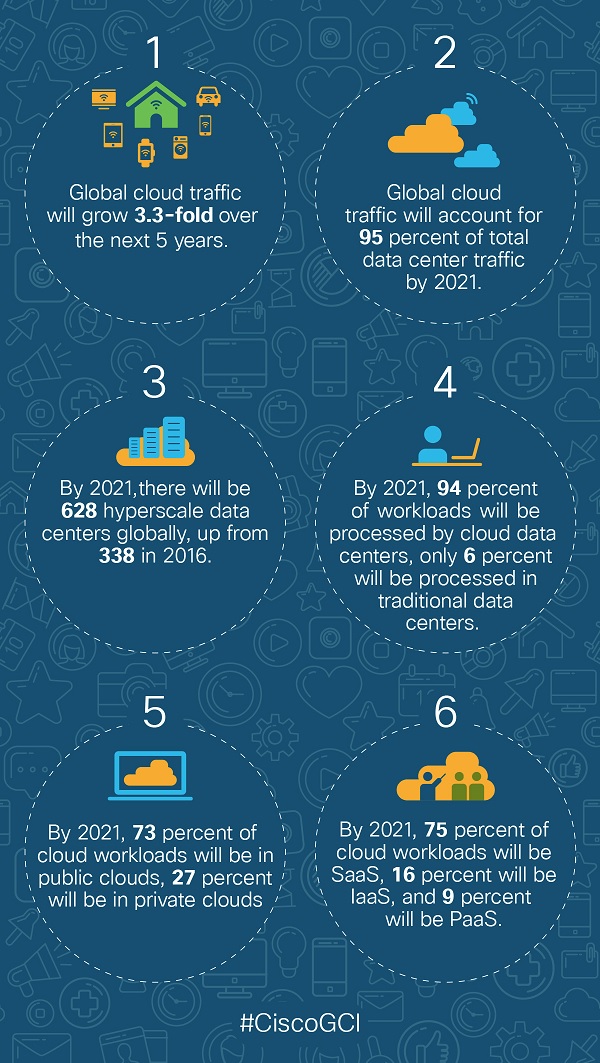Globally, cloud data center traffic will represent 95 percent of total data center traffic by 2021, compared to 88 percent in 2016, according to the Cisco Global Cloud Index (2016-2021).
According to the study, both consumer and business applications are contributing to the growing dominance of cloud services over the Internet. For consumers, streaming video, social networking, and Internet search are among the most popular cloud applications. For business users, enterprise resource planning (ERP), collaboration, analytics, and other digital enterprise applications represent leading growth areas.
Driven by surging cloud applications, data center traffic is growing fast. The study forecasts global cloud data center traffic to reach 19.5 zettabytes (ZB) per year by 2021, up from 6.0 ZB per year in 2016 (3.3-fold growth or a 27 percent compound annual growth rate [CAGR] from 2016 to 2021).
Global Cloud Index Highlights and Key Projections:
Data center virtualization and cloud computing growth
■ By 2021, 94 percent of workloads and compute instances will be processed by cloud data centers; 6 percent will be processed by traditional data centers.
■ Overall data center workloads and compute instances will more than double (2.3-fold) from 2016 to 2021; however, cloud workloads and compute instances will nearly triple (2.7-fold) over the same period.
■ The workload and compute instance density for cloud data centers was 8.8 in 2016 and will grow to 13.2 by 2021. Comparatively, for traditional data centers, workload and compute instance density was 2.4 in 2016 and will grow to 3.8 by 2021.
Growth in stored data fueled by big data and IoT
■ Globally, the data stored in data centers will nearly quintuple by 2021 to reach 1.3 ZB by 2021, up 4.6-fold (a CAGR of 36%) from 286 EB in 2016.
■ Big data will reach 403 exabytes (EB) by 2021, up almost 8-fold from 25 EB in 2016. Big data will represent 30 percent of data stored in data centers by 2021, up from 18 percent in 2016.
■ The amount of data stored on devices will be 4.5 times higher than data stored in data centers, at 5.9 ZB by 2021.
■ Driven largely by IoT, the total amount of data created (and not necessarily stored) by any device will reach 847 ZB per year by 2021, up from 218 ZB per year in 2016. Data created is two orders of magnitude higher than data stored.
Applications contribute to rise of global data center traffic
■ By 2021, big data will account for 20 percent (2.5 ZB annual, 209 EB monthly) of traffic within data centers, compared to 12 percent (593 EB annual, 49 EB monthly) in 2016.
■ By 2021, video streaming will account for 10 percent of traffic within data centers, compared to 9 percent in 2016.
■ By 2021, video will account for 85 percent of traffic from data centers to end users, compared to 78 percent in 2016.
■ By 2021, search will account for 20 percent of traffic within data centers by 2021, compared to 28 percent in 2016.
■ By 2021, social networking will account for 22 percent of traffic within data centers, compared to 20 percent in 2016
SaaS most popular cloud service model through 2021
■ By 2021, 75 percent (402 million) of the total cloud workloads and compute instances will be SaaS workloads and compute instances, up from 71 percent (141 million) in 2016. (23% CAGR from 2016 to 2021).
■ By 2021, 16 percent (85 million) of the total cloud workloads and compute instances will be IaaS workloads and compute instances, down from 21 percent (42 million) in 2016. (15% CAGR from 2016 to 2021).
■ By 2021, 9 percent (46 million) of the total cloud workloads and compute instances will be PaaS workloads and compute instances, up from 8% (16 million) in 2016. (23% CAGR from 2016 to 2021).
For the purposes of the study, cloud computing includes platforms that enable ubiquitous, on-demand network access to a shared pool of configurable computing resources (e.g., networks, servers, storage, applications, and services) that can be rapidly provisioned and released with minimal management effort or service provider interaction. Deployment models include private, public, and hybrid clouds. Cloud data centers can be operated by service providers as well as private enterprises.

